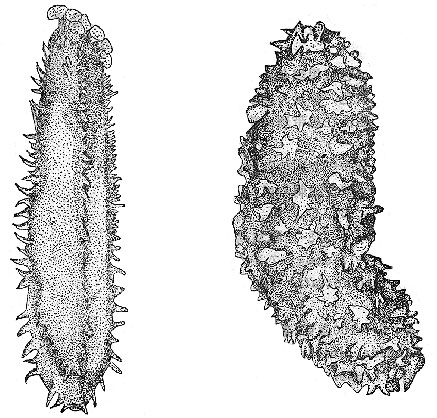SEA CUCUMBER
The sea cucumber (Stichopus chloronotus, S. variegatus, S. japonicus, and other related species in the family Holothurioidea) has been revered by Chinese cooks since ancient times. In particular, sea cucumber meals have been offered on numerous special occasions, especially New Year celebrations. The sea cucumber is rated along with several other delicacies, such as shark fin and bird’s nest soup, as a disease preventive and longevity tonic. It was listed as a medicinal agent in the Bencao Congxin (New Compilation of Materia Medica) by Wu Yiluo in 1757.
The popular Chinese name for sea cucumber is haishen, which means, roughly, ginseng of the sea (see: Notes on the term shen in renshen). It is often known medicinally as fangcishen (fang = four-sided, ci = thorny; referring to the spiky protrusions that emanate from four sides, as appears in one of the common species), or, in abbreviated form, fangshen.
To prepare the sea cucumber after it is collected, the internal organs are removed, and dirt and sand are washed out of the cavity. It is then boiled in salty water and dried in the air to preserve it. When readied for use in making food, it is softened in warm water and then boiled.
According to analysis by principles of traditional Chinese medicine, the sea cucumber nourishes the blood and vital essence (jing), tonifies kidney qi (treats disorders of the kidney system, including reproductive organs), and moistens dryness (especially of the intestines). It has a salty quality and warming nature. Common uses include treating weakness, impotence, debility of the aged, constipation due to intestinal dryness, and frequent urination. Sea cucumber is traditionally served in the form of a soup.
From the nutritional viewpoint, sea cucumber is an ideal tonic food. It is higher in protein (at 55%) than most any other food except egg whites (at 99%), and it is lower in fat than most foods (less than 2%). For nourishing essence and blood in persons who suffer from emaciation, it is combined in soup with pork. For impotence, frequent urination, and other signs of kidney deficiency, sea cucumber is cooked with mutton. For yin and blood deficiency, especially manifesting as intestinal dryness, sea cucumber is combined with tremella (yiner, the silvery tree mushroom).
For modern applications, the dried or extracted sea cucumber is useful as a nutritional supplement, prepared in capsules or tablets. The fully dried material has a protein concentration as high as 83%. From the Western medical viewpoint, the reason sea cucumber is valuable is because it serves as a rich source of the polysaccharide condroiton sulfate, which is well-known for its ability to reduce arthritis pain: as little as 3 grams per day of the dried sea cucumber has been helpful in significantly reducing arthralgia. Its action is similar to that of glucosamine sulfate, which is useful for treating osteoarthritis. Sulfated polysaccharides also inhibit viruses; there is a Japanese patent for sea cucumber chondroitin sulfate for HIV therapy.
Chinese studies reveal that sea cucumbers also contain saponin glycosides. These compounds have a structure similar to the active constituents of ginseng, ganoderma, and other famous tonic herbs. Additional Chinese studies indicate anticancer properties of both the sea cucumber saponins and the polysaccharides.
BIBLIOGRAPHY
Anderson EN, The Food of China, 1988 Yale University Press, New Haven, CT.
Zhang Enchin (Chief Editor), Chinese Medicated Diet, 1988 Publishing House of Shanghai College of Traditional Chinese Medicine, Shanghai.
Tang Weici, Chinese medicinal materials from the sea, Abstracts of Chinese Medicine 1987; 1(4): 571–600.
Liu Jilin and Peck G, Chinese Dietary Therapy, 1995 Churchill Livingstone, London.
Note: Coastside Bio Resources in Maine is the largest harvester of sea cucumber in the United States. This organization has produced an encapsulated dry sea cucumber product, Ginseng of the Sea (which is primarily given as a remedy for persons with arthritis), and has provided the Institute for Traditional Medicine with sea cucumber powder for use in making Holothalgate, a formula that includes red marine algae, vitamin C, and bioflavonoids, which is mainly prescribed to help prevent herpes eruptions in persons chronically infected, but which may also be used as a general tonic and as a therapy for arthralgia. Coastside Bio Resources has developed an anti-inflammatory extract of sea cucumber trademarked as Sea Chondroitin and produced a formulation of it with glucosamine, called ArthriSea. Another organization, Coastside Research, directed by Peter Collin, has helped initiate international laboratory research into the various pharmacological properties of sea cucumber.

Figure 1: Stichopus chloronotus (left); Thelenota ananas(right).
April 1998

Tidak ada komentar:
Posting Komentar